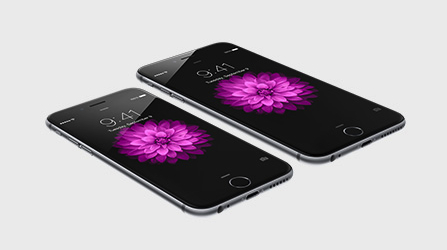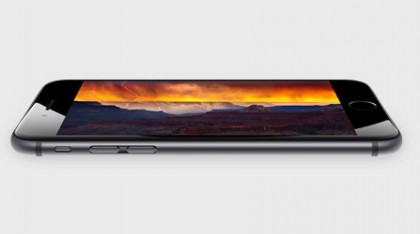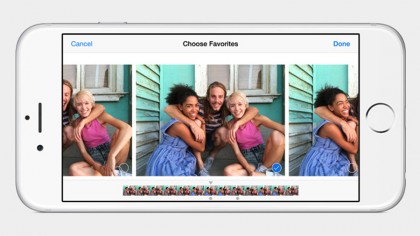iPhone 6 vs iPhone 6 Plus: Apple's two latest smartphones go head to head
Will you supersize your next iPhone?

It's been a long time since Apple was under this much pressure to impress with a new iPhone. After 2013's rather straightforward upgrade, the Cupertino company needed something special, and something to fight back against the moves being made by its rivals.
The iPhone 6 and the iPhone 6 Plus are Apple's counter-punches to critics who said it hadn't innovated enough with the iPhone 5S, but how do they stack up against each other? And which one should you be spending your cash on?
- Read our iPhone 6 review
iPhone 6 vs iPhone 6 Plus: Design
The world's iPhones have got thinner and lighter since 2007 but in late 2014 Apple really worked some iPad Air-style magic on the dimensions of its latest handsets. The 4.7-inch iPhone 6 is just 6.9mm thick (shaving another 10% off the already slim 7.6mm iPhone 5S) while the 5.5-inch iPhone 6 Plus has a thickness of just 7.1mm.
The differences over the 2013 batch of iPhones is noticeable, and Jony Ive's team have rounded the corners of the iPhone 6 and 6 Plus to accentuate the slimness of these devices, as well as adding more premium metal to the mix.

The familiar iPhone button layout has been rejigged to allow for this new super-thin frame. Most significantly, the power button moves from the top to the side, while the bands running across the top and bottom of the devices are introduced to improve reception and connectivity.
These are two almost impossibly svelte handsets, with the iPhone 6 offering a slightly thinner design than its more expensive iPhone 6 Plus sibling. If you're a phablet fan or have particularly large hands, the bigger model is the one you'll have your eyes on. The same gold, silver and grey options are available across the board.
Also built into the iPhone 6 and the iPhone 6 Plus is the NFC technology required for Apple's new mobile payments system, Apple Pay, so you can use either phone to make contactless payments when you're out and about.
Sign up for breaking news, reviews, opinion, top tech deals, and more.
The iPhone 6 is a little more pocket-friendly which means it could prove to be a more convenient wallet replacement, especially for people who want to travel light.
iPhone 6 vs iPhone 6 Plus: Screen
The screen is where we find the biggest gap between the iPhone 6 and the iPhone 6 Plus - it's the main distinction between the models. The iPhone 6's display measures 4.7 inches corner-to-corner at a resolution of 1334 x 750 pixels (or 326 pixels-per-inch).
The 6 Plus ups this to 5.5 inches and a resolution of 1920 x 1080 pixels (401ppi). These figures put the iPhone 5S firmly in the shade, with its 1136 x 640 pixel, 326ppi display.
All that means you get more pixels on the 6 Plus spread across a larger area. Website text will be bigger, movies can be viewed from further away, text will be sharper, and so on. It also makes the device harder to hold in just one hand, but the one-handed mode built into iOS 8 (the operating system that the iPhone 6 and iPhone 6 Plus ship with) should be able to alleviate some of those problems. The weight of either the iPhone 6 or the iPhone 6 Plus shouldn't be a problem, at least.
One extra benefit you get from the additional screen space on the iPhone 6 Plus is the ability to run apps in landscape mode, iPad-style - it's a bonus for anyone who wants more room to work with on their handset. If you use any serious productivity apps on the go then bear this in mind, though compatibility varies between apps.
A recent update to Netflix's app means that Netflix now supports 1080p video playback on the iPhone 6 Plus' 5.5-inch screen. This means that if you're a regular user of the Netflix app and want the best possible playback quality on an iPhone, then you'll want to go with the iPhone 6 Plus.
iPhone 6 vs iPhone 6 Plus: Camera
Both of iPhone 6 and the iPhone 6 Plus feature the same camera lens technology. That means an 8-megapixel shooter (as with the iPhone 5S) but an improved f/2.2 aperture and processing algorithms, so your pictures are going to look better than ever in all conditions.
Bear in mind that the iPhone 6 will be easier to handle with one hand when framing shots, but the iPhone 6 Plus will give you more viewfinder screen space to get your image lined up correctly.

The iPhone 6 Plus features optical image stabilization (OIS), while the iPhone 6 only has regular image stabilization.
Camera specialist DxO Labs has run a number of benchmark tests with the iPhone 6 and iPhone 6 Pluscameras to see how they compare not only to each other but also to their closest rivals.
The tests measure the exposure and contrast, colour, autofocus, artefacts and noise levels to determine an overall score to award to each phone's camera.
In the tests both the iPhone 6 and iPhone 6 Plus scored 82, the highest ever score for a smartphone camera. The Samsung Galaxy S5 and the Sony Xperia Z3 come joint second with 79 points.
Although both the iPhone 6 and the iPhone 6 Plus score the same, the benchmarks did highlight the various strengths and weaknesses between the two iPhones.
For example the Optical Image Stabilisation feature of the iPhone 6 Plus helps reduce image ghosting on HDR images compared to the iPhone 6, with the OIS feature helping to align the multiple images used in the HDR photos.
However during video recording the iPhone 6 Plus suffered from light video stabilisation artefacts that the iPhone 6 didn't, leading DxO Labs to state that the iPhone 6's camera is slightly better for video and the iPhone 6 Plus' camera better for still images.
Although it is close between the iPhone 6 and iPhone 6 Plus, there are a number of tips and tricks that you can use to further improve the camera quality in both phones.

Dave is a freelance tech journalist who has been writing about gadgets, apps and the web for more than two decades. Based out of Stockport, England, on TechRadar you'll find him covering news, features and reviews, particularly for phones, tablets and wearables. Working to ensure our breaking news coverage is the best in the business over weekends, David also has bylines at Gizmodo, T3, PopSci and a few other places besides, as well as being many years editing the likes of PC Explorer and The Hardware Handbook.